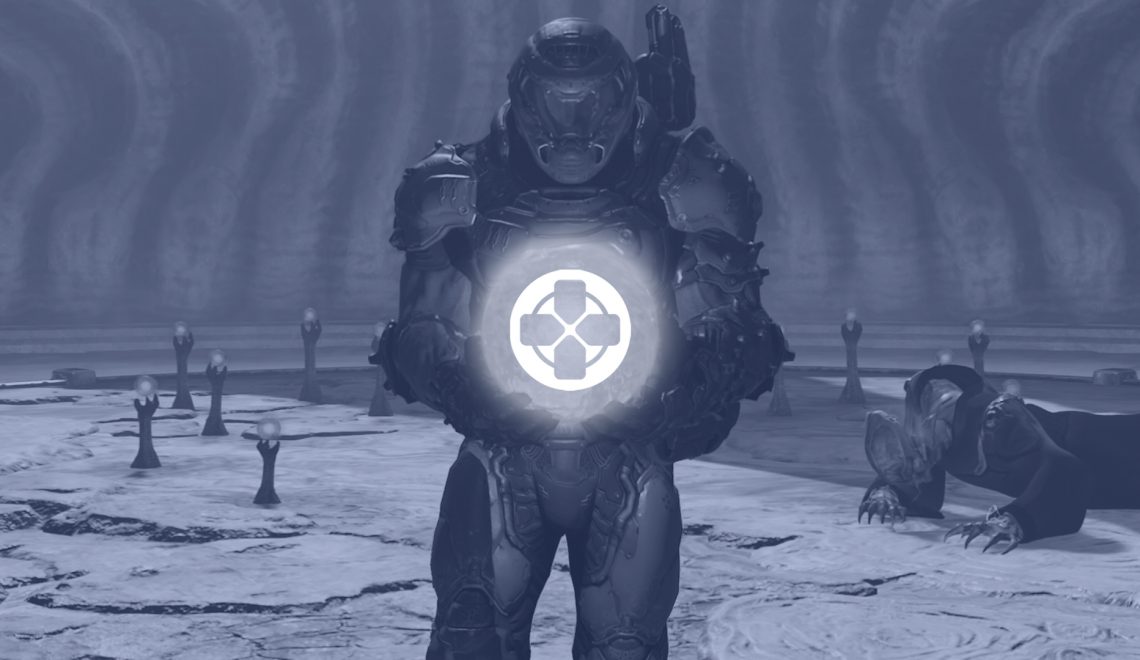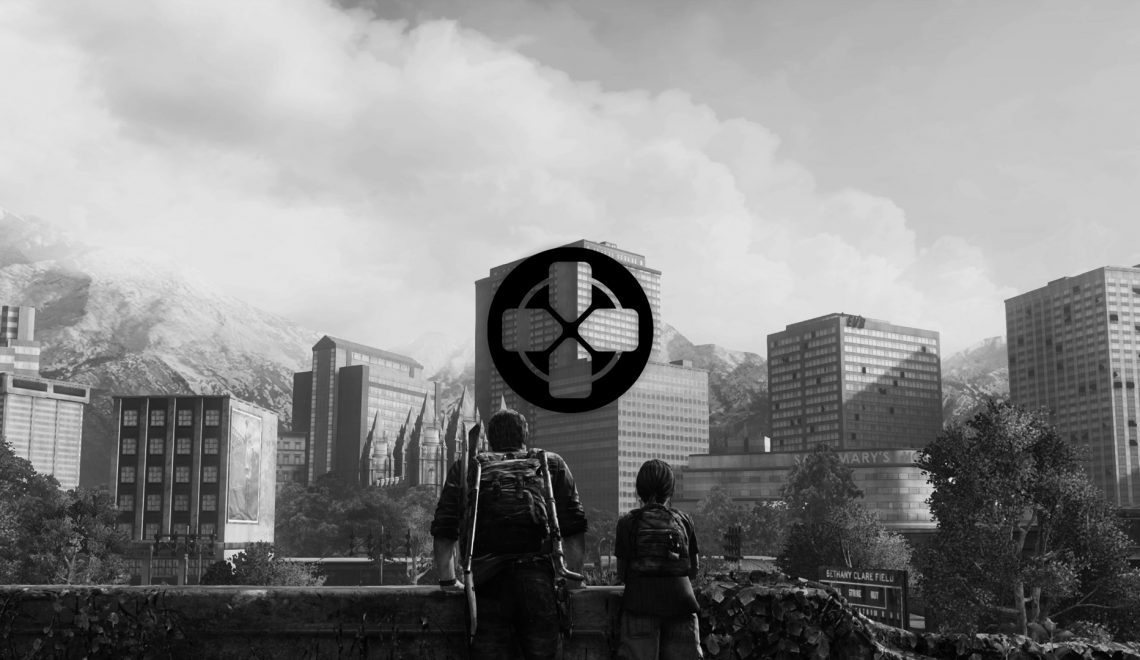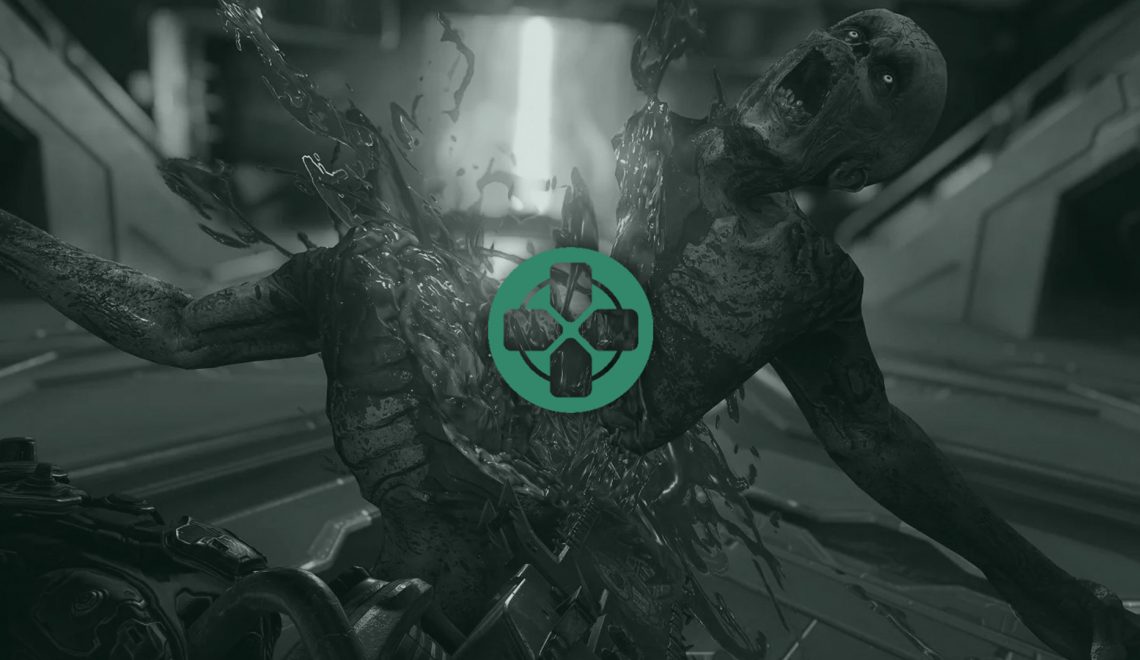The safest way to bring a grand console franchise to portable platforms is to water down its gameplay, visuals, and scope. A typical route for console action-adventure series is to make them portable side scrollers with a few mechanics pulled from the full-fledged experience. Batman: Arkham Origins Blackgate and Assassin’s Creed Chronicles are prime examples that more or less get the job done. It’d be great to always have one-to-one conversions that you can play on the go, but hardware limitations are an understandable roadblock, which aren’t limited to the technical sort. Remember this ridiculous add-on for the Nintendo 3DS? Simplified button layouts can pose issues.
As always, there are developers who crave to fit the square through a circle hole. There should be more losers than winners because of this ambition, but more often than not, examples like Assassin’s Creed Liberation, Kingdom Hearts: Birth by Sleep, Resident Evil: Revelations, Killzone: Mercenary, Metroid Prime: Hunters, Uncharted: Golden Abyss – these turn out to be decent at the least (even better in rare circumstances) compared to their home console counterparts! It’s a testament to developers’ ingenuity to push boundaries and create within constraints like Naughty Dog and Guerilla Games. Another name that should pop up more often is Ready at Dawn Studios.
The team was truly put on the map with their “cinematic” third-person shooter The Order: 1886. While level design and encounters left much to be desired (not to mention the boss fights), the game gets too much of a bad rap for its short length. It remains one of the most gorgeous titles on the PlayStation 4 with a fantastic setting and art direction supported by weighty, satisfying gunplay. You could say the game’s bells and whistles pick up the slack for its lack of substance, so I’d love to see the team return with another big project someday.
However, The Order: 1886 isn’t where Ready at Dawn first proved its talent. The team came out of the gate rolling with the Jak and Daxter PSP spin-off Daxter. It was received well and showed how the studio could replicate and expand upon the original vision of existing IPs. Ready at Dawn solidified this reputation with two God of War spin-offs titled Chains of Olympus and Ghost of Sparta. They’re made of the quality I’ve come to expect from the franchise, so when I say they hold up as comparable experiences to the main trilogy, that should already tell you something. I’ll be covering both in this review, but first things first – when did the developer peak over the horizon?
Analyze
The first God of War’s creative director David Jaffe said his position rarely existed in game development in the early 2000s. He had to make a case for the role’s validity to guide the production and vision of his projects with Sony from Twisted Metal to God of War. With developers growing larger along with the games they’ve made, it’s laughable to imagine a studio not having a creative director today. I mention this because the informality of high-profile game development is a wonder to witness in retrospect. Ready at Dawn’s formation is a textbook illustration, so let’s rewind the clock a bit.
Ru Weerasuriya was originally going into car design. When he showed off his portfolio near the end of his academic pursuits, he had an unexpected guest (Nilo Rodis-Jamero, who was an art and costume designer for Star Wars and Star Trek films) point him to the game industry. Ru already loved Blizzard Entertainment’s Warcraft, so he sent in a resume, did an art test in front of the team, and got the gig. He worked on vehicle designs for Starcraft and contributed his talents to Warcraft. He left after several years with teammate and software engineer Andrea Pessino, who encouraged Ru to join him and Didier Malenfant (an ex-Naughty Dog programmer) to start their own studio. Because of Didier’s prior work, he had the connections and approval to pitch a Jak & Daxter title for the recently announced PSP in 2004. The nameless, ragtag bunch of devs approached Sony’s Shuhei Yoshida with a modest design doc and some concept art and … well, the rest is history. They decided that the studio’s founders – Ru, Andrea, and Didier – would form the initials of their name: Ready at Dawn.
Daxter’s development was hellish for the 25-person team (which would grow to around 40 later on) with the mass of content they produced coupled with the PSP’s limited, changing specs, but as I mentioned before, they delivered a spin-off that stands tall amidst the main series, so they set their eyes on a new challenge. They contacted Santa Monica Studios after being amazed by the first God of War during Daxter’s development. It turns out the team was already thinking about expanding the franchise and loved the idea of Ready at Dawn creating a side scroller version of God of War, but this is Ready at Dawn we’re talking about. The team convinced Santa Monica they could make a true God of War experience on the PSP. They made mistakes early on by altering Kratos’ established moveset to change gameplay for the sake of change (which led to Ru becoming creative director to hone the studio’s focus), but like Daxter, this game proved to be a success with its critical and financial reception. It took two years to make and released on March 4, 2008, breaking the top 10 best-selling games for that month with around 340,500 units moved and over 3.2 million worldwide sold to date. It remains the highest-ranked PSP title on Metacritic, surpassing the likes of Grand Theft Auto: Chinatown Wars and Metal Gear Solid: Peace Walker.
You’re probably expecting an equally storied history for Ghost of Sparta, aren’t you? Unfortunately, there’s not too much to go on because Ready at Dawn didn’t film any illuminating, transparent documentaries during development like Santa Monica. What I did find out is that Ready at Dawn washed its hands of God of War after Chains of Olympus. The studio heads often make the point that they don’t like doing the same thing twice, so they sent back the team’s PSP dev kits upon completing Chains of Olympus to consider options with the PlayStation 3 and Xbox 360. However, focus tests and Sony’s persistence motivated Ready at Dawn to return and push the PSP to its maximum while deepening Kratos’ backstory. The latter can be attributed to God of War II’s creative director Cory Barlog, who penned the story near the beginning of his prodigal tale after leaving Santa Monica for several years.
Ru stepped down as creative director and let Dana Jan take over. He’d been a lead level designer for Chains of Olympus and worked on World of Warcraft before joining Ready at Dawn. The team started production during August 2008 and released Ghost of Sparta on November 2, 2010, which sold half as much as its predecessor worldwide, though it still comfortably ranks among the most well-received PSP titles. In addition, both games were remastered in-house with the PlayStation 3 God of War Origins Collection that came out a year later, and no, this isn’t like your usual “remaster” fare. Ready at Dawn took games that were originally running at 480p and brought them up to 1080p. This included doubling the frame rate to 60 and quadrupling the assets’ texture resolution. Even the cutscenes were re-rendered frame by frame. It’s no wonder these remasters exceed their PlayStation 2 predecessors on a technical level, but artistically? Narratively? Design-wise? Let’s see how these games stack up in the God of War pantheon.
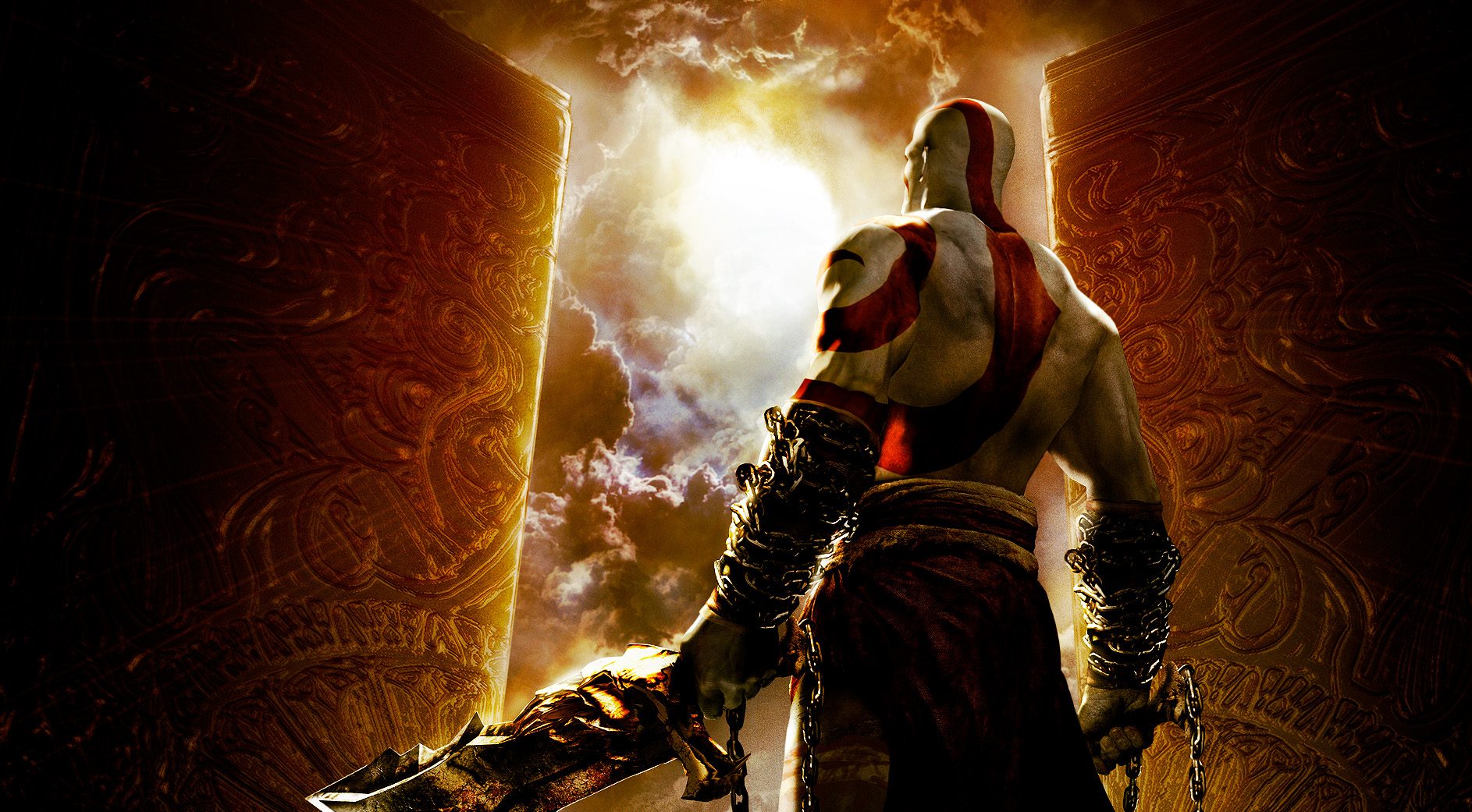
Diagnose: Chains of Olympus
You can tell when something was originally made for a portable device. No matter how much a developer polishes or enhances the visuals, the intrinsic design and scope of environments tell all. Freeing up the inputs for a traditional controller usually shows how the original title had constraints with movement and action, too. What makes the PlayStation 3 port of Chains of Olympus fascinating is how it feels and looks so close to its PlayStation 2 brethren, and you can tell from the start since you’re treated to an over-the-top sequence typical for God of War that would’ve floored me years ago on the PSP. The premise is set in the middle of Kratos’ decade-long service to the Olympians. He’s been sent to fend off Persians from seizing the city of Attica. Kratos slices his way through their king’s henchmen and not only slays their leader, but also their rampaging, serpentine basilisk. Kratos looks at his work and accuses the gods of sending him on petty errands. Then, as if in immediate response, the sun crashes to the earth, casting the world into an unending darkness and the gods into a deep slumber. Kratos goes to where the sun crashed and realizes it’s actually Helios’ chariot. He’s the god of the sun and has somehow been abducted, forcing the reluctant Spartan on a case to find out where Helios has gone.
Chains of Olympus is one of the only God of War games without a central, clear antagonist. You’re led to believe that Morpheus, the Primordial god of dreams, has something to do with Helios’ disappearance since his minions surround Helios’ chariot and he made the Olympians fall asleep. You discover that Morpheus only took advantage of the situation since the Titan, Atlas, struck down Helios. But why? When Kratos is led into the Underworld for answers, the ferryman of the River Styx prevents him from moving forward with his quest. How deep does this rabbit hole go? Who’s pulling the strings of this masterplan? Most of the games gauge your interest with exciting backstories, grand action, and simple revenge, but Chains of Olympus carries you along with its shifting winds of mystery. It’s an unusual type of story for the series that results in hitting roadblocks here and there for the sake of a prolonged pace, like when Charon casts Kratos into Tartarus, which has you climbing back up to him for two hours to continue where you left off. However, Ready at Dawn strikes a good balance of keeping things moving without lingering in one place for too long with this narrative approach.
Who’s behind Helios’ capture? None other than one of the best villains resulting in one of the best boss fights in the God of War saga: Persephone. It’s a crying shame that her role is limited to the last half hour because she’s a rich, meaningful parallel to Kratos. As the queen of the underworld, she protects the pure souls in her paradise, including Kratos’ daughter. She tricks the Spartan into giving up his power to be with her, then revealing her plot to destroy the pillar of the world and bring down Olympus with the power of Helios in Atlas’ hands. She will stop at nothing – even suicide – to exact her revenge on the gods who ruined her life. She doesn’t mention how she can be partially blamed for her situation by secretly enjoying her marriage to Hades and breaking her vow to eat anything in the underworld until she returned to her mother Demeter (there’s some extra Greek mythology for you). Nonetheless, Hades’ forced kidnapping of her and Zeus allowing it to happen is terribly tragic. She’s like a mirror to Kratos with her life story. Her actions are understandable yet wrong, resembling the troubled cycle of mixed responsibility that led to Kratos’ path of world-ending revenge.
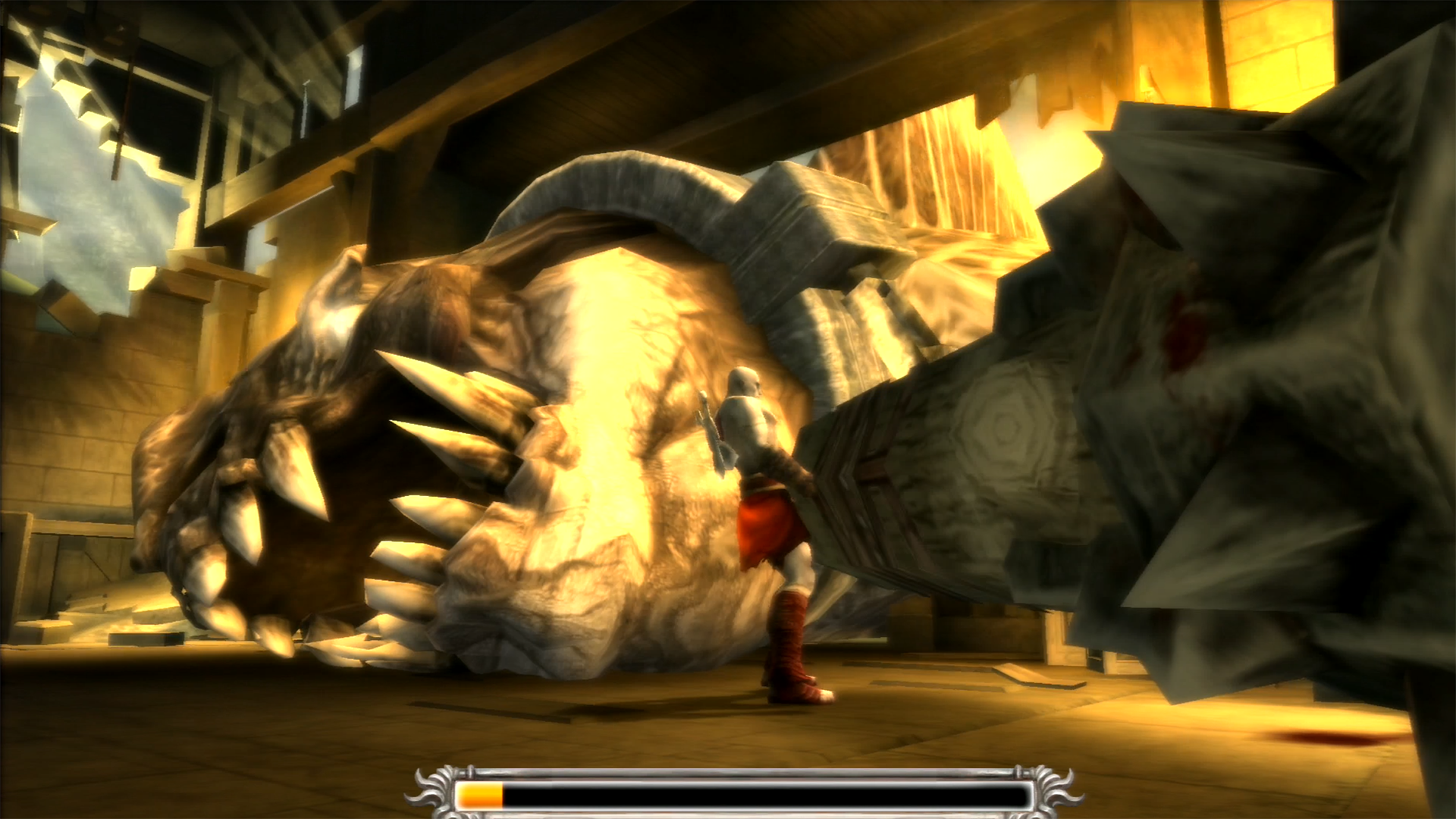
Would you mind holding this for me?
I wish Persephone had played a pivotal role from the start, perhaps secretly recruiting Kratos to free Atlas under the pretense of lies after saving Attica. On the Spartan’s journey, he’d be pulled left and right by Persephone and the Olympians in a contest of allegiance and search for truth. The Olympians would remind Kratos of his servitude and Persephone’s true intentions while she would encourage his hatred for and distrust of the Olympians with her own circumstances. It’d culminate in a betrayal that would feel all the more rage-inducing and surprising. Even still, Persephone plays a brief yet compelling part, leading into one of my favorite moments in the franchise where you’re forced to push away Kratos’ daughter to stop Persephone. The mechanic that draws Kratos closer to enemies for glory kills suddenly morphs into one where you’re forced to separate him from one of the only people he ever loved.
The moment comes across as a bit contrived, but takes Jaffe’s love of fusing interactivity with storytelling in a minor way, as seen in God of War’s powerful scene where the player hugs Kratos’ family to keep them safe from his evil doppelgangers. Ru said, “Adding that moment with Calliope was always something that was going to stir debate, with some people being affected by it and others not caring one bit,” Ru said. “But that was the challenge of trying to make people play their emotions rather than just see events being played in front of them.” Afterwards, you kill the pure souls of Elysium to gain back Kratos’ power, which is a small yet illuminating metacommentary on Kratos’ character. His power is synonymous with evil; he cannot be good if he is to be powerful. I think that says even more about his character, solidifying my point that Chains of Olympus holds your attention with an unexpected, engaging plotline that, somewhat regrettably, holds out some of the saga’s strongest punches for the very end.
Since we’re dealing with a younger, pre-god Kratos, his basic moveset would be closest to what you’d find in the first God of War. All of my prior critiques of the combat stand here, and really, Ready at Dawn’s team should be commended for replicating the rhythm and feel of the core gameplay while styling the animation in their own way, which is arguably less stilted in-game and (especially) during cutscenes compared to Santa Monica’s earlier work. Chains of Olympus may not surpass God of War II’s combat (maybe on par with storytelling), but I’d say it possesses an equally compelling batch of puzzles. This is notable within the first couple hours in Helios’ chariot, where there are lots of great sorting puzzles with more layers than usual. Puzzles actually trail off in depth as the game lengthens with one section solely devoted to combat for an hour, so while this suggests the game would feel lopsided, it doesn’t come across as such in a bad way due to its short length.
As for platforming, what’s nice is how more annoying bits have been removed with no ropes to shimmy across or beams to balance on. Nothing is added to or improved upon though, so the platforming, while competent, remains stagnant and feels more like a regression to the first game’s traversal.
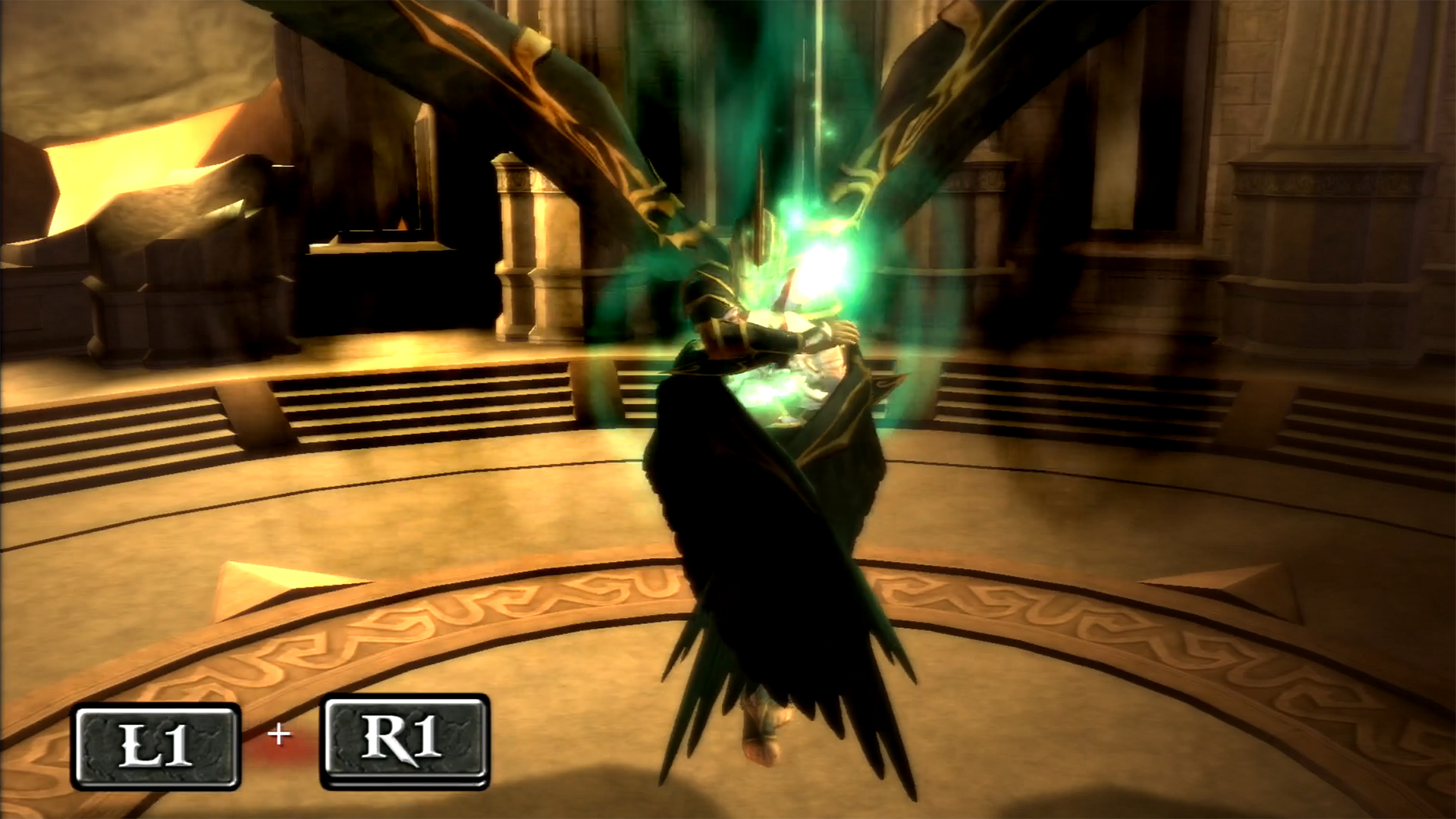
Persephone is downright manipulative. She hugs and comforts Kratos to go be with his daughter in the middle of the boss fight, and you have to continue rejecting this desire or she’ll kill you with it.
With the absence of a rage mode and less weapons and abilities compared to God of War II, the same stagnation could be said of combat, given that Kratos has no new tricks with his Blades of Chaos. However, what new abilities there are along with a stellar extra weapon make up for the decrease in features. The abilities consist of a small yet perfect array of powers for varied situations. The Efreet is a Persian demon Kratos summons for a fiery AoE attack (which is also the first and only time a deity outside of Greek mythology appears in the God of War saga); Light of Dawn is derived from Helios’ power to hurl balls of light, which can swipe pesky harpies from the sky or down archers from afar; Charon’s Wrath is an incredibly useful corrosive that eats away at tough armor that’d take too long to destroy with anything else. Ready at Dawn also finds a way to ret-con another shield into Kratos’ arsenal, which would have been sorely missed since it remarkably improved the flow of combat in God of War II.
As for Kratos’ next new toy, it’s an appropriately heavy-hitting, slow alternative called Zeus’ Gauntlet. I didn’t use it much since it shows up three-quarters through the story … and because I became lazy and ignored upgrading anything else besides the Blades. Besides, I found it too slow for my liking. But in spending more time with the gauntlet, I truly sold myself short by letting it gather dust. It’s incredible for closing distances on enemies with a devastating punch, getting them up in the air with an uppercut, and blowing back surrounding baddies with a ground pound. Whenever I was overwhelmed or close to taking out enemies (some of which were annoyingly programmed to take exact turns), I began naturally switching to the gauntlet after softening foes up with the blades. It not only has a bigger moveset and more distinct purpose than Athena’s Blade in the first game, but is also a more fully-fledged weapon than the Barbarian Hammer or Spear of Destiny from the second title. I hate how late the gauntlet comes into Chains of Olympus, but it shows how Ready at Dawn poked at better weapons before Santa Monica finally got it with God of War III.
As a side note, Chains of Olympus only has three boss fights, and while all of them are good (especially Persephone’s scary moveset), it would’ve been nice to see at least one or two more minor ones. Though, in a roundabout way, the short length of the game means you fight one every two hours, so the low amount feels like a good balance … but two wrongs don’t make a right, if you will.
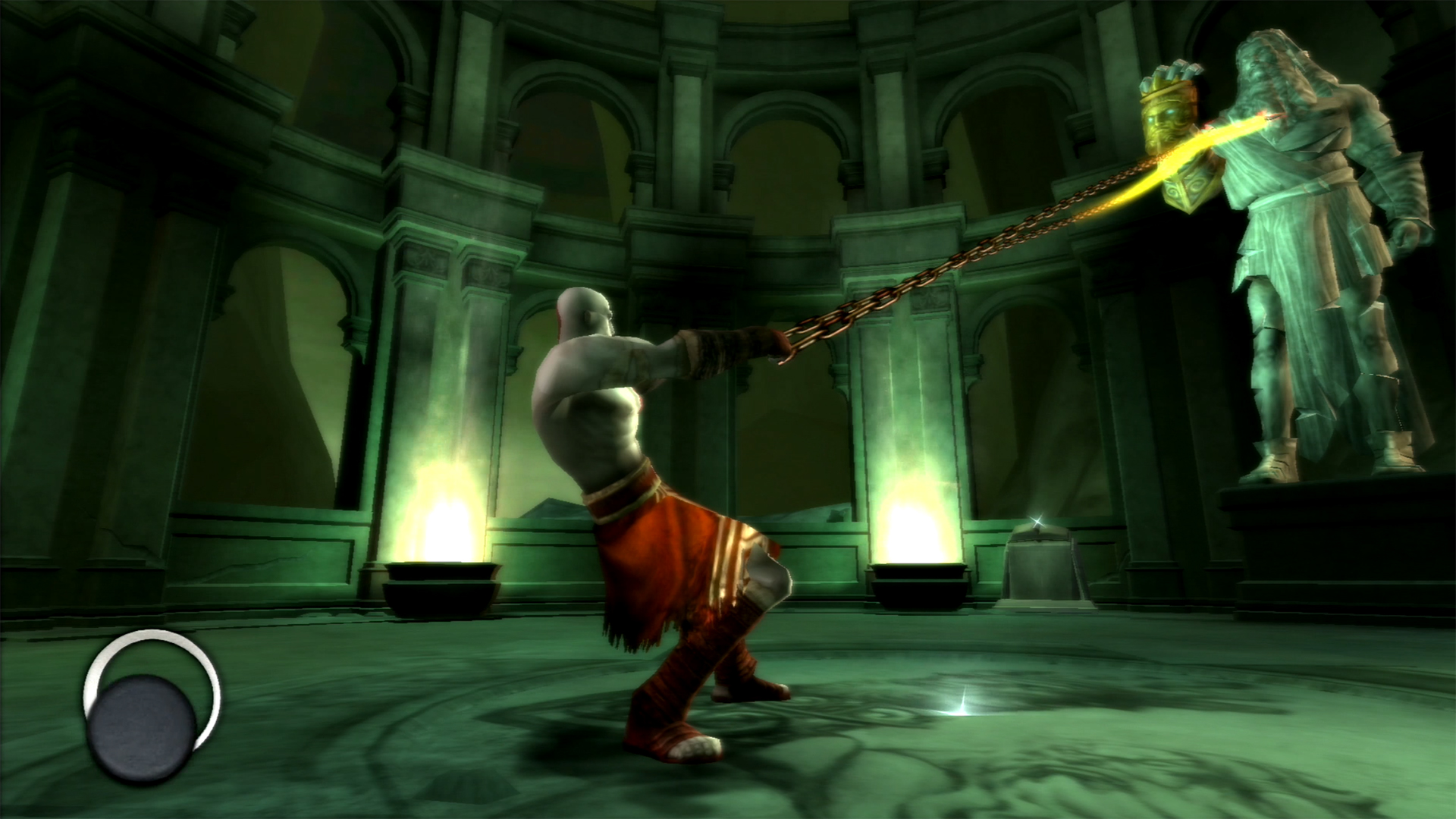
I’m going tear down your monument and take that, thanks.
I already mentioned how you can tell that environments have simpler backdrops (though not in all cases!) to accommodate the PSP’s capabilities, and I know it’s a vague critique, but there’s a “softness” to the graphics that looks a bit off. Other than that, assets in the near backgrounds and foreground are more than detailed enough. Like the first game, the settings are rather dull in totality with a mix of grays, browns, and reds, but that’s not speaking for their intrinsically good design sense combined with impressive lighting, effects, and animation. The music and voice acting is acceptable, but I will say the sound quality remains impressive considering this was for the PSP.
Prescribe: Chains of Olympus
Chains of Olympus is pure God of War with no unnecessary comprises. That’s more than I was expecting, which contains points of excellence that rise among its peers with a premise that sounds uninteresting, but unfolds with formative events that culminate into what might just be my favorite finale in the saga. While some aspects of gameplay aren’t fleshed out and even stripped in some ways, the new tools and breadth of puzzles bring life to what could have otherwise felt like a retread of prior games highlighting a boring side mission in Kratos’ mortal servitude to the Gods, but it’s much more than that, easily shining a light brilliant enough to demand attention.
With Ghost of Sparta taking place after Kratos’ ascension to Ares’ throne, it stands to reason that the experience should be more godlike on all counts. For the most part, it is.
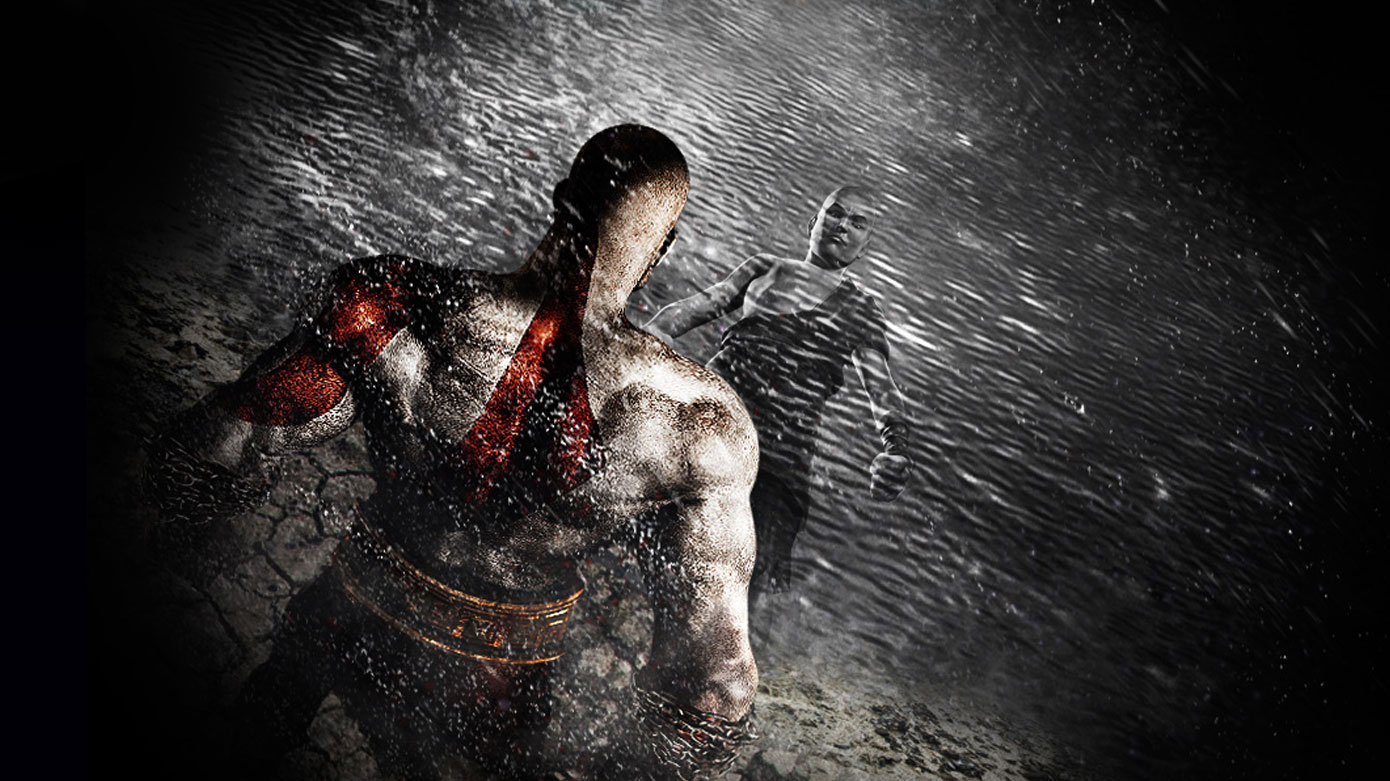
Diagnose: Ghost of Sparta
It’s intentional that Ready at Dawn stokes nostalgic déjà vu with Ghost of Sparta’s introduction. Sometime after Kratos became the new god of war, he began having visions of an old woman crying out to him from her secret imprisonment in Atlantis. Alongside them came Kratos’ memories of his younger brother Deimos being captured. The Spartan isn’t known for being the passive type, so he sets out with a legion of ships to assault Poseidon’s kingdom, and it all starts out with a part-leviathan and part-octopus monster tearing the fleet apart until Kratos reaches Atlantis’ shores. It sounds familiar, but it’s a good kind of familiar.
The game comes close to matching the exotic variety of the second game. Atlantis is a sleek, opulent kingdom caught in perpetual rainfall, and then Kratos’ battle with the sea monster takes him to the heart of these mines in a nearby volcano. Other locations include the nearby island of Crete: a city under construction that’s been devastated because, well, Kratos set off the volcano. You’ll then journey to the snowy mountains of the Aroania Pass, which was likely inspired5 by 300’s iconic scene of Leonidas fighting the wolf. These demonstrate how the settings and scope are an improvement over Chains of Olympus, and that goes for character models, cutscenes, weather effects, and minor touches like water and powdery snow flowing and drifting across things. Ready at Dawn promised to push the PSP to its max, and this remastered version delivers with visual ambition that couldn’t run on a PlayStation 2.
Just like Chains of Olympus, Ghost of Sparta has more freedom to deepen Kratos’ motives in relation to his straightforward, earth-shattering antics in the trilogy. Whereas the former game gave validity to the Spartan’s impatience and grief in the first God of War, Ghost of Sparta explains Kratos’ bloodlust in the second title. He talks about how Athena and Zeus betray him after he mindlessly tears apart other Greek cities with his Spartans, but he absolutely deserves it for misdirecting his revenge against innocents. It’s the ultimate temper tantrum, unlike his partially justified yet foolish killing of the Olympians elsewhere. Rather than awkwardly finding ways to make Kratos’ rampaging against all of Greece a reasonable act of revenge, Ghost of Sparta homes in on Kratos’ apathy and blind anger by having him undergo further emotional trauma.
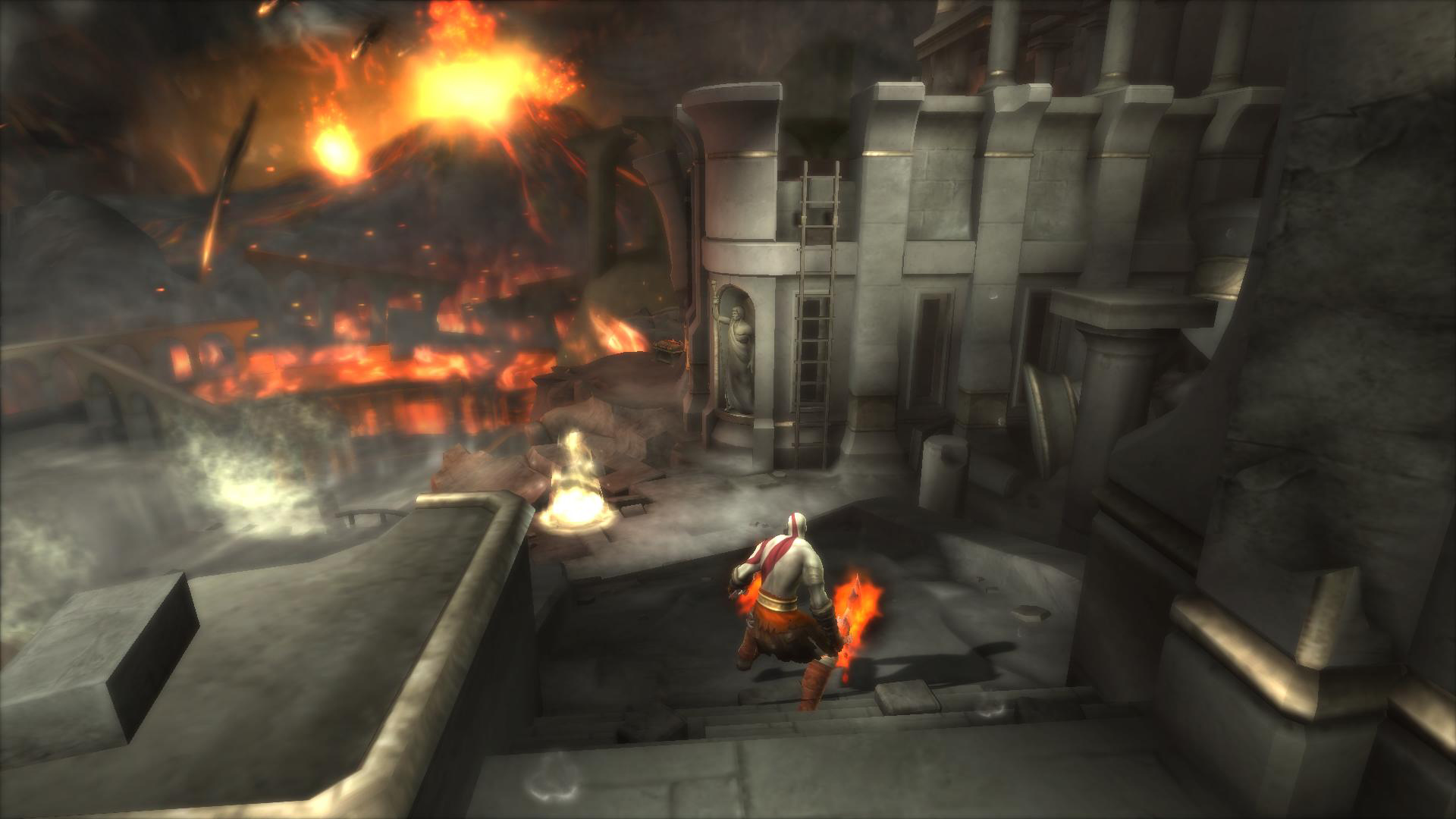
Oops … did I do that? Come on, guys, I gotta save my brother! Civilizations crumbling in the process is morally justifiable!
He’s forced to kill the woman he saw in his visions, his own mother, after she tells him that Zeus is his father (which doesn’t make sense because he seems oblivious to this when Athena tells him in God of War II, so yeah). When Kratos discovers his brother is alive and finds him a broken man, he watches him die and carries his body to rest (a controllable sequence reminding me of a certain scene from Brothers: A Tale of Two Sons). His daughter and now his mother and brother were all thought lost, only to die soon after Kratos realizes they weren’t. The game even delivers more on the theme of distrust I wish had been more present throughout Chains of Olympus by having Kratos discover the Olympians not only kidnapped his brother, but also lied to him about it. Ready at Dawn excels in allowing players to sympathize with such a terrible antihero. There’s plenty of small yet great moments that contribute to the universe as well, with my favorite being the exploration of Kratos’ relationship with Sparta through several soldiers and visiting the city at one point.
Interestingly enough, Ghost of Sparta is like a reversal of my thoughts with Chains of Olympus in some ways. Whereas the latter has memorable puzzles that shine from the start, the former doesn’t have many that made me pause in thought with the exception of two or three. Most of them consist of one-step problems with immediately apparent solutions. Others, if you can call them puzzles, deal with platforming, which is, surprisingly, among the best the series has offered. While some questionable means of traversal return like climbing across ropes and beam balancing, swinging around and grappling have been drafted in from God of War II. There are entirely new features like sliding down cliffs with directional influence, leaping across chasms directly onto other ledges or ropes, and using the Blades’ chains to pull Kratos through underwater currents. There are a couple timed, intense sections as well, so all in all, the platforming is some of the most thorough and well-integrated in the series.
Kratos’ Blades receive a couple minor adjustments compared to Chains of Olympus. Rather than counter with a shield, he can directly do this with follow-up attacks with the Blades. Grapple attacks are brought in as well, but since the basic moveset doesn’t demand change, what merits discussion is how there’s a charge ability where Kratos sprints a small distance to pin his enemy to the ground. From there, it functions similarly to the grab in that you can attack a foe in three different ways. What makes it special is how you pummel enemies with your fists for as long as you like until they expire. It can be a risky and almost unnecessary move to make in tough circumstances, but if used right, it’s a fun move by getting up close and personal, so you can bet I ended most combat sequences with this move.
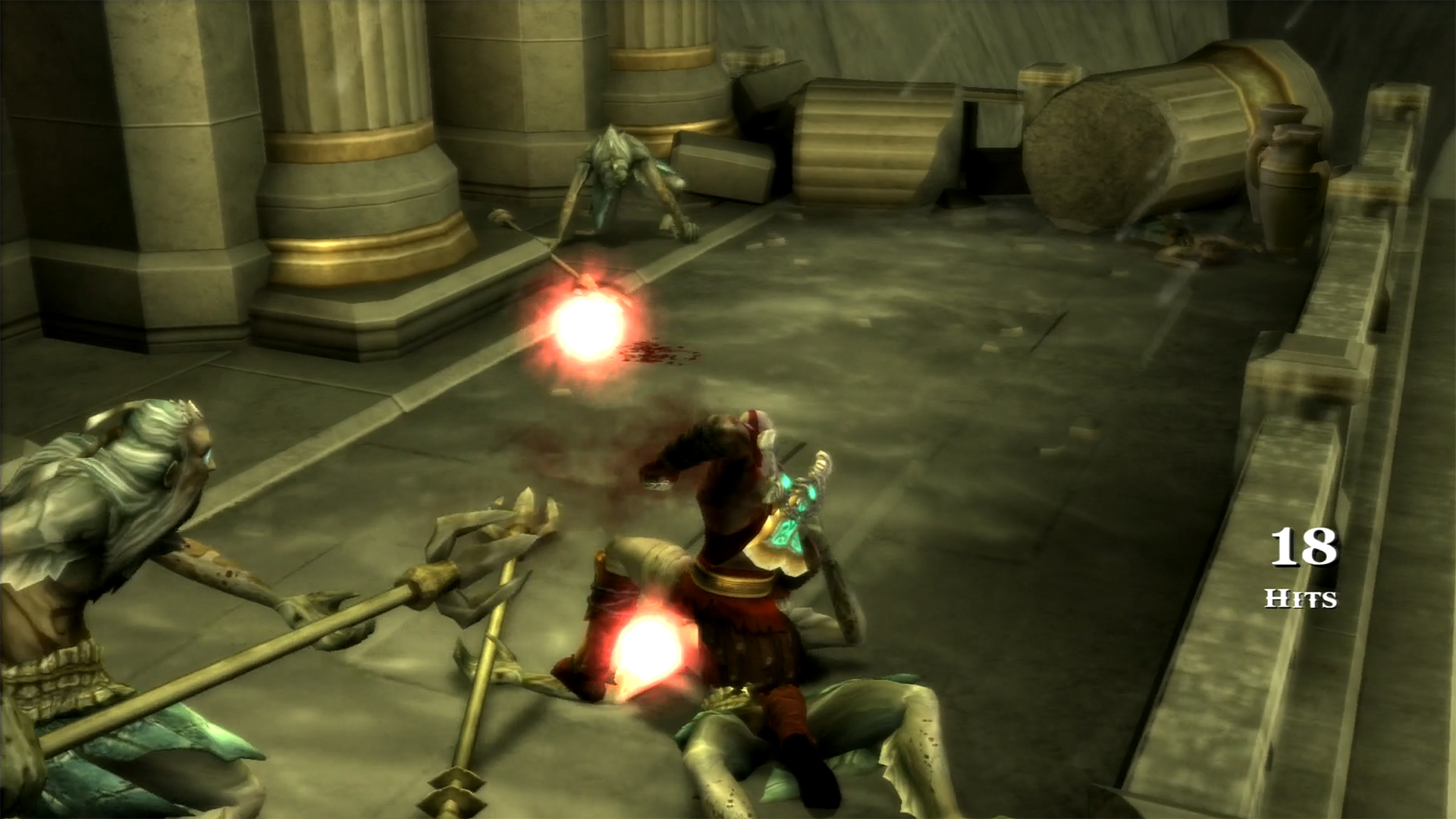
Seeing Kratos barrel toward you at full speed is a downright terrifying thing to imagine. I’d also be concerned if I had red orbs popping out of me with every punch.
There’s a hybrid of the traditional Rage mode and God of War III’s ability meter here called Thera’s Bane that grants Kratos a temporary power boost to his Blades as they erupt in fire. It’s made useful by taking down hefty enemies or those with armor, but what I don’t like is how the ability recharges too fast, making the limitation uselessly frustrating half of the time. I would’ve preferred a great increase in its power and time to recharge to make its application more satisfying, while throwing in some special, devastating combos similar to that in God of War II with Titan’s Wrath. I would’ve also liked Thera’s Bane to have been integrated with one of the coolest weapon sets Kratos ever acquires – his old Spartan spear and shield from his military days.
Unfortunately, the Arms of Sparta feels more like a gimmick for killing enemies that can’t be reached. In terms of power, range, or feel, they don’t bring enough to the table to compel switching, especially due to the weapon’s slower delivery of hits. I like the idea of being able to throw spears to varying effects and moving while defending (the only time in the franchise where you can do so), but this weapon combo – despite some flashy moves and integration with traversal (like God of War III’s shallow attempts with some weapons) – isn’t quite as fun or useful as Zeus’ Gauntlet.
Ghost of Sparta steps up to the plate with two more boss fights compared to its portable predecessor, and I’d say they’re equally entertaining. Much like Chains of Olympus’ final boss, I think fighting Ghost of Sparta’s version is one of the series’ best because of how emotionally engaging it feels in relation to the story. You really want to destroy Persephone after she baits Kratos into leaving his daughter, and the same passion guides you while fighting Deimos’ captor, the god of death, alongside him. It’s the only time you battle with an ally in the saga, and you could say it’s an emotional rollercoaster as the fight ramps up.
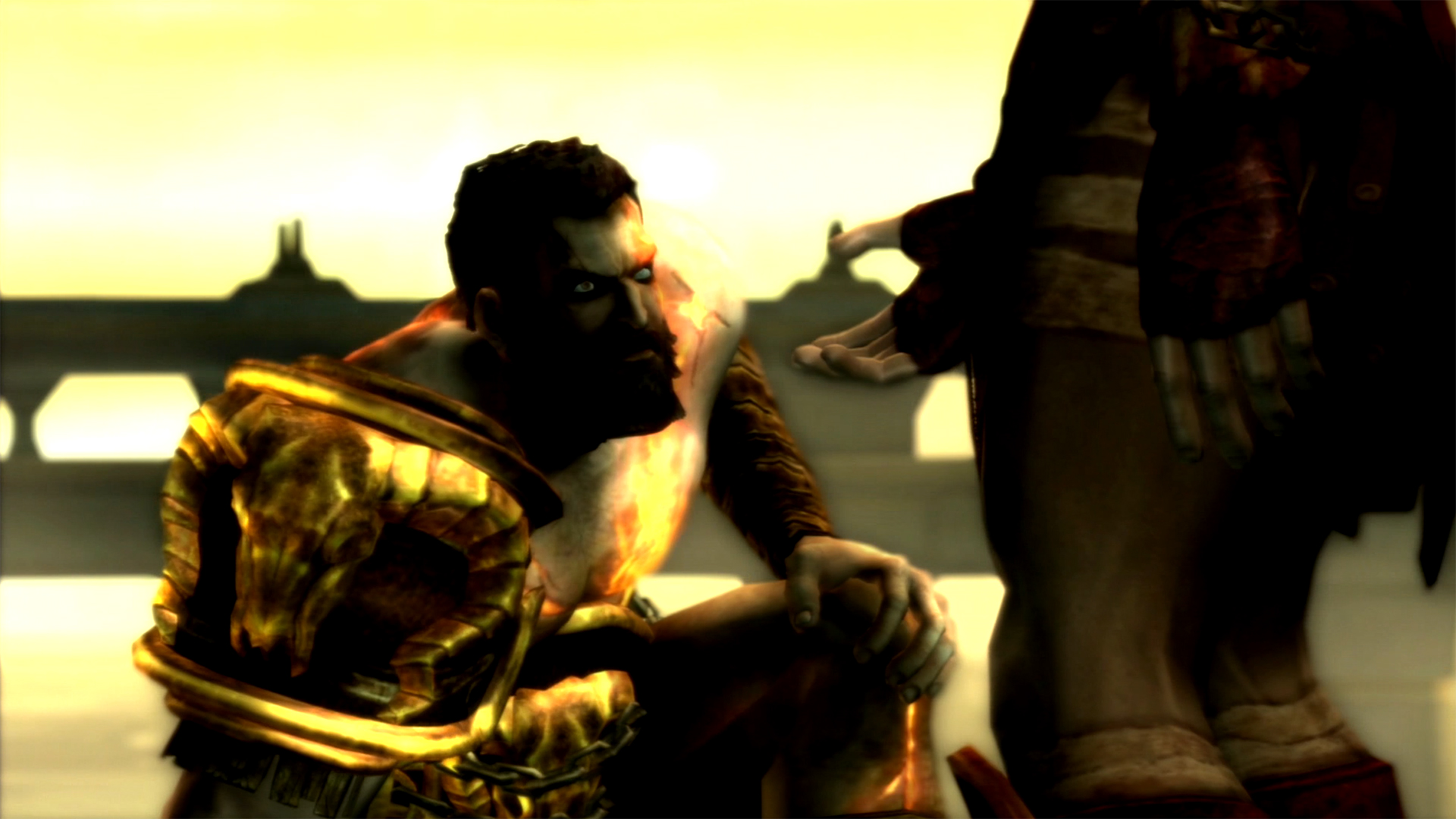
“A Spartan never lets his back hit the ground. Right, brother?”
There are some new foes worth mentioning like elemental variations of harpies and the bizarre Geryon: a multi-armed monster crackling with electricity and a teleporting ability that teaches you to react quickly. There’s also the Automaton, which is wholly mechanical and can only be damaged using Thera’s Bane. It’s the only enemy that makes that ability’s otherwise tame limitations feel challenging as you dodge and wait to slowly topple it. One enemy I particularly despised is the Keres Wraith. I’ve always groaned with wraiths since they’re a powerful, elusive force only made tolerable in God of War III since you could rip them from the ground. However, this game’s variant is unrelenting. They can swiftly leap across an entire area and catch you mid-dodge in a nasty QTE event. They’re hard to see and react to, and even when you can, you’ll endure blade attacks that spawn underneath Kratos and incapacitate him for a good two seconds, leaving plenty of time for others to pounce. They were frustrating for the wrong reasons, but besides this lone enemy type, Ghost of Sparta has a steady, mixed flow of old and new enemies that never grow tiresome over the game’s 10+ hour length, which speaks for its larger breadth of levels that address the prior game’s notably low playtime.
Prescribe: Ghost of Sparta
Ghost of Sparta rounds out with equally good combat in contrast to Chains of Olympus, but takes steps forward to be an even better experience in every other way. The story of loss and lies contributes much to God of War II’s setup and Kratos’ complicated life. The platforming is literally and figuratively leaps and bounds above most of the game’s peers, also boasting astonishing graphics in light of the PSP’s capabilities and Ready at Dawn’s laudable PlayStation 3 remastering. The game may not go beyond with its combat or puzzles, but Ghost of Sparta was a herculean effort on the developer’s part, and it shows with an outstanding sendoff more than worthy of the success it should have known eight years ago.

